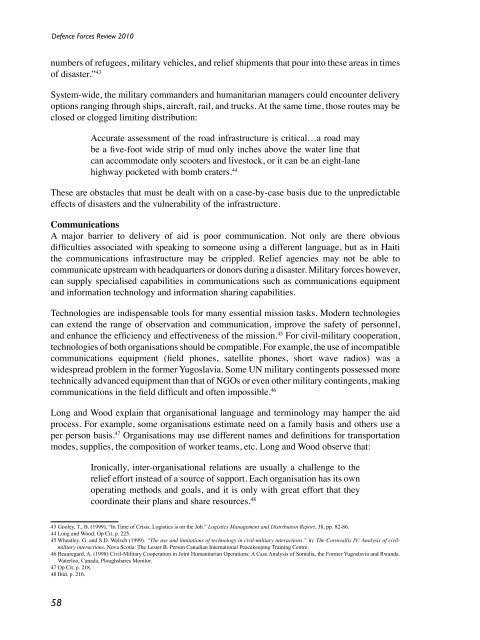Challenges of Civil Military CooperationThe military has several virtually unique resources. They can both protect and defendthemselves and break down the resistance of others with violence, they have rapid accessto strategic and tactical transport resources, they can be self-sufficient for a longer period,and they have specialised aircraft capacities, maritime resources, reconnaissance, intelligencecapacities, and an effective communications network. 33 The military logistic network andmachinery are extensive and speedy (claiming delivery in about five days from projectapproval, compared to five months for the EU and UN). 34Humanitarian organisations, especially NGOs and development organisations, who maintaina presence within a country, will often be the first on the scene when a disaster strikes. Longand Wood state that these “young and predominantly single…[NGO] staffers are not usuallytrained for emergency situations.” 35 Natsios further elaborates that most recruits are trainedon the job, with few standardised instructional resources, “…and where NGO doctrine doesexist, it comes out of generally shared experiences and responses, is seldom written down, andis not always followed uniformly.” 36Thomas points out that there may be problems with employee reliability stemming from lackof training. 37 There is a notable lack of employees who are knowledgeable in supply chain orlogistics management. In the logistics area, the challenges facing humanitarian organisationsare the formal qualification of logistics staff, optimisation of their logistics activities andthe integration of activities across business functions. 38 Long notes that “most people fromdevelopment agencies…have backgrounds in public policy or third world development,and professional logisticians are rare.” 39 Lack of funding for back-office infrastructureand processes and the need to upgrade the logistics function including its information andknowledge management aspect have attracted the first wave of structured business-humanitarianpartnerships. 40 Binder and Witte conclude that the role of business in humanitarian relief isbecoming more prominent even if it remains a limited phenomenon. 41Infrastructure DegradationInadequate transportation and communications infrastructure is another barrier to effectivedelivery of aid. In the DMTP logistics handbook, it states “the overall effectiveness ofrelief logistics often depends on the level of prior investment in both the transport andcommunications infrastructure and how far relief requirements have been considered in theplanning.” 42 Rapid onset of a disaster may degrade the country’s existing infrastructure to thepoint where delivery of aid is severely hampered, as in the recent case of Haiti. As noted byGooley, “Often…transportation infrastructure is in poor condition and cannot handle the huge33 Eriksson, P. (2000). “Civil-Military Co-ordination in Peace support operations – an impossible necessity?” In: The Journal of Humanitarian Assistance.Accessed: 26 September 2007.34 Pugh, M. (2001). “Civil-Military relations in peace support operations: hegemony or emancipation?” Plymouth: University of Plymouth.35 Op Cit, p. 217.36 Natsios, A.S., (1995) “The International Humanitarian Response System,” Parameters, 25, p. 70.37 Op Cit, p. 7.38 Oloruntoba, R. and Gray, R., (2006), ‘Humanitarian aid: an agile supply chain?’ Supply Chain Management – An International Journal, 11 (2), pp.115-120.39 Long, D. (1997), “Logistics for disaster relief: engineering on the run,” IIE Solutions, Vol. 29 No. 6, p. 27.40 Van der Laan, E.; M.P. de Brito & S. Vermaesen (2007), “Logistics Information and Knowledge Management Issues in Humanitarian Aid Organisations”proceedings of the SIMPOI/POMS conference, Brazil, August 8-10.41 Binder, A. & J. M. Witte (2007), “Business Engagement in Humanitarian Relief: Key Trends and Policy Implications,” Humanitarian Policy Group,Overseas Development Institute, London, UK.42 Op Cit, p. 12.57
<strong>Defence</strong> <strong>Forces</strong> <strong>Review</strong> <strong>2010</strong>numbers of refugees, military vehicles, and relief shipments that pour into these areas in timesof disaster.” 43System-wide, the military commanders and humanitarian managers could encounter deliveryoptions ranging through ships, aircraft, rail, and trucks. At the same time, those routes may beclosed or clogged limiting distribution:Accurate assessment of the road infrastructure is critical…a road maybe a five-foot wide strip of mud only inches above the water line thatcan accommodate only scooters and livestock, or it can be an eight-lanehighway pocketed with bomb craters. 44These are obstacles that must be dealt with on a case-by-case basis due to the unpredictableeffects of disasters and the vulnerability of the infrastructure.CommunicationsA major barrier to delivery of aid is poor communication. Not only are there obviousdifficulties associated with speaking to someone using a different language, but as in Haitithe communications infrastructure may be crippled. Relief agencies may not be able tocommunicate upstream with headquarters or donors during a disaster. Military forces however,can supply specialised capabilities in communications such as communications equipmentand information technology and information sharing capabilities.Technologies are indispensable tools for many essential mission tasks. Modern technologiescan extend the range of observation and communication, improve the safety of personnel,and enhance the efficiency and effectiveness of the mission. 45 For civil-military cooperation,technologies of both organisations should be compatible. For example, the use of incompatiblecommunications equipment (field phones, satellite phones, short wave radios) was awidespread problem in the former Yugoslavia. Some UN military contingents possessed moretechnically advanced equipment than that of NGOs or even other military contingents, makingcommunications in the field difficult and often impossible. 46Long and Wood explain that organisational language and terminology may hamper the aidprocess. For example, some organisations estimate need on a family basis and others use aper person basis. 47 Organisations may use different names and definitions for transportationmodes, supplies, the composition of worker teams, etc. Long and Wood observe that:Ironically, inter-organisational relations are usually a challenge to therelief effort instead of a source of support. Each organisation has its ownoperating methods and goals, and it is only with great effort that theycoordinate their plans and share resources. 4843 Gooley, T., B. (1999), “In Time of Crisis, Logistics is on the Job.” Logistics Management and Distribution Report, 38, pp. 82-86.44 Long and Wood; Op Cit, p. 225.45 Wheatley, G. and S.D. Welsch (1999). “The use and limitations of technology in civil-military interactions.” in: The Cornwallis IV: Analysis of civilmilitaryinteractions, Nova Scotia: The Lester B. Person Canadian International Peacekeeping Training Centre.46 Beauregard, A. (1998) Civil-Military Cooperation in Joint Humanitarian Operations: A Case Analysis of Somalia, the Former Yugoslavia and Rwanda.Waterloo, Canada, Ploughshares Monitor.47 Op Cit, p. 218.48 Ibid, p. 216.58
















